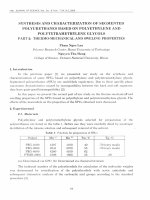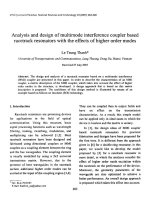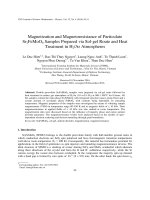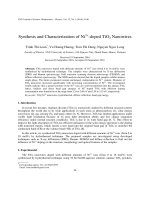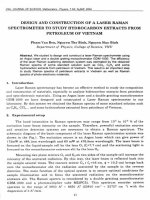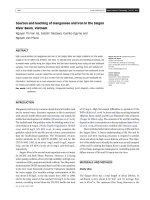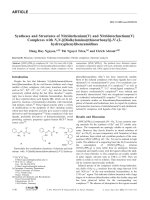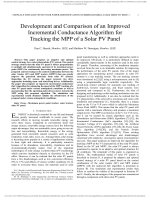DSpace at VNU: Sources and Exchange of Particulate Organic Matter in an Estuarine Mangrove Ecosystem of Xuan Thuy National Park, Vietnam
Bạn đang xem bản rút gọn của tài liệu. Xem và tải ngay bản đầy đủ của tài liệu tại đây (456.61 KB, 9 trang )
Estuaries and Coasts (2012) 35:1060–1068
DOI 10.1007/s12237-012-9487-x
Sources and Exchange of Particulate Organic Matter
in an Estuarine Mangrove Ecosystem of Xuan Thuy National
Park, Vietnam
Nguyen Tai Tue & Tran Dang Quy & Hideki Hamaoka &
Mai Trong Nhuan & Koji Omori
Received: 20 June 2011 / Revised: 9 February 2012 / Accepted: 11 February 2012 / Published online: 29 February 2012
# Coastal and Estuarine Research Federation 2012
Abstract The spatio-temporal variations in stable isotope
signatures (δ13C and δ15N) and C/N ratios of particulate
organic matter (POM), and physicochemical parameters in
a creek water column were examined in an estuarine mangrove ecosystem of Xuan Thuy National Park, Vietnam. The
objective was to examine the factors influencing creek water
properties, and the sources and exchange of POM in this
important mangrove ecosystem. The diel and seasonal variations in water temperature, flow velocity, pH, dissolved
oxygen, and salinity demonstrated that tidal level, season,
and biological factors affected the creek water properties.
Mangroves had relatively low δ15N and very low δ13C
values, with respective average values of 1.5±0.9‰ and
−28.1±1.4‰. The low mangrove leaf δ15N indicated minor
anthropogenic nitrogen loading to the mangrove forests. A
significant positive correlation between POM–δ13C and salinity along the axis of Ba Lat Estuary, Red River, indicated
that marine phytoplankton (δ13C value, −21.4±0.5‰) was
the predominant source of POM at the estuary mouth. Based
Electronic supplementary material The online version of this article
(doi:10.1007/s12237-012-9487-x) contains supplementary material,
which is available to authorized users.
N. T. Tue
Graduate School of Science and Engineering, Ehime University,
2-5 Bunkyo-cho,
Matsuyama, Japan
N. T. Tue (*) : H. Hamaoka : K. Omori
Center for Marine Environmental Studies, Ehime University,
2-5 Bunkyo-cho,
790-8577, Matsuyama, Japan
e-mail:
T. D. Quy : M. T. Nhuan
Faculty of Geology, Hanoi University of Science,
334 Nguyen Trai, Thanh Xuan,
Hanoi, Vietnam
on the co-variation of δ13C and C/N ratios, marine phytoplankton and mangrove detritus were predominant in POM
of major creeks and small creeks, respectively. During the
diurnal tidal cycle, the dynamics of POM were affected by
sources of organic matter, tidal energy, and seasonal factors.
The contribution of mangrove detritus to POM reached a
maximum at the low tide and was enhanced during the rainy
season, whereas marine phytoplankton contribution was
highest at high tide.
Keywords Particulate organic matter . Mangrove
ecosystem . Stable isotopes . Xuan Thuy National Park .
Vietnam
Introduction
Mangrove ecosystems are highly productive coastal systems, forming both a critical boundary between the sea
and land and providing essential habitats for plants and
animals. They are traditionally considered to play a critical
role in the biogeochemical carbon cycle in (sub)trophic
regions, being an important source of particulate organic
matter (POM) and dissolved organic carbon in coastal waters
(Jennerjahn and Ittekkot 2002). The export of mangrove detritus is correlated with total litter production (Mfilinge et al.
2005), particularly during the rainy season (Dittmar and Lara
2001a; Alongi 2009).
Mangrove-derived POM has been recognized as a major
food source for a variety of invertebrate species (Camilleri
1992) and contributes up to 84% of the diet of commercially
important juvenile prawns (Chong et al. 2001). Therefore, the
dynamics of POM are likely to influence the whole food web
in the mangrove ecosystem (Chong et al. 2001; Bouillon et al.
2002). However, the factors influencing the sources and
Estuaries and Coasts (2012) 35:1060–1068
exchange of POM have not yet been fully understood in
mangrove ecosystems, particularly in developing countries
such as Vietnam.
Mangrove creeks act as a major route for transport of
mangrove detritus to adjacent environments (Alongi 2009)
and likewise the import of phytoplankton from coastal
waters (Romigh et al. 2006; Bouillon et al. 2007). Thus,
the creek systems play a vital role in maintaining the physical and biological structure of the mangrove ecosystem, as
well as the out-welling of nutrients and organic matter from
mangrove forests. In addition, POM, nutrients and other
physicochemical properties of creek water are highly influenced by tidal level (Bouillon et al. 2007), season (Romigh
et al. 2006), and biogeochemical processes in sediments
(Kristensen 2008). The POM pool often originates from
variable sources (e.g., mangrove detritus, marine phytoplankton, benthic microalgae, and terrestrially derived organic matter) (Rezende et al. 1990; Bouillon et al. 2007).
Therefore, to understand the dynamics of POM in mangrove
ecosystems, it is important to examine the contributions of
mangrove detritus under different tidal, spatial, and seasonal
scales.
In the present study, we test the hypothesis that the
physicochemical properties of water column and the sources
Fig. 1 Sampling sites within
mangrove ecosystem of Xuan
Thuy National Park in northern
Vietnam. Map numbers are
based on the order number of
spatial POM samples. MS
denotes monitoring site, and E1
to E6 denote sampling sites
from the Ba Lat Estuary. Site
E7 (15 km from the estuary
mouth) is not shown on the map
1061
and dynamics of POM in an estuarine mangrove ecosystem
are controlled by the changes in tidal level, seasonal, and
biological factors. We investigate the spatio-temporal observations of stable isotopes (δ13C and δ15N) and C/N ratios of
POM and the physicochemical parameters (water level, flow
velocity, water temperature, dissolved oxygen (DO), pH,
salinity, and total suspended matter (TSM)) of creek water
for (1) examining the factors influencing the physicochemical properties of the creek water and (2) determining the
spatio-temporal variations in POM constituents in the estuarine mangrove ecosystem.
Materials and Methods
Study Area
The present study was conducted in an estuarine mangrove
ecosystem of Xuan Thuy National Park (XTP) in Northern
Vietnam. The XTP is located along the south entrance of Ba
Lat Estuary (BLE), Red River (Fig. 1). A detailed description of the XTP is shown in the Electronic supplementary
material. The XTP has two major creek systems (Tra and
Vop Creeks) that meander through the dense mangrove
1062
forests. Tra Creek is the largest and is one of the major
connections between mangrove forests and the sea. Therefore, Tra Creek likely plays a vital role in the physical and
biological processes underlying the development and sustenance of the mangrove ecosystem.
Field Sampling
Field sampling was carried out in both rainy (from 10
to 16 September, 2009) and dry seasons (from 9 to 26
March, 2010). During the rainy season, a monitoring
site (MS, 20° 14′ 15.2″ N, 106° 33′ 56.7″ E) was
established in the middle of Tra Creek for collecting
water samples for POM and physicochemical measurements at 1-h intervals during a diurnal tidal cycle from
14:25, 11th to 14:25, 12th September, 2009. To assure
no site contamination by anthropogenic sources and the
examination of a natural system, the MS location was
chosen within the most developed mangroves and far
from human activity and settlements.
During the dry season, water samples were likewise
collected during a diurnal tidal cycle from 10:40, 11th to
10:40, 12th March, 2010 for determination of POM and
physicochemical parameters, following the same method
and location (MS) as during the rainy season. To examine
the potential marine POM end-member, estuarine water
samples were collected along a salinity gradient of the
BLE during flood tide, and the sampling sites were assigned
from E-1 to E-7 (Fig. 1). In addition, creek water samples
were spatially collected during flood tide in order to examine the sources of POM in the geographical distribution
(Fig. 1).
Water samples were all taken at 30 cm below the
surface by a Van Dorn bottle. POM samples were collected by filtering 0.5 L of water through pre-weighed
and pre-combusted (at 550°C) 47 mm Whatman GF/F
glass fiber filters. After collection, POM samples were
lightly rinsed with distilled–deionized water to remove
salt residue, immediately placed on ice, and transported
to the field laboratory where the samples were dried at
60°C for 24 h.
At the MS station, flow velocity and water temperature
were simultaneously recorded by a velocity–temperature
compact instrument (Compact–EM, model AEM–HR, Alec
electronics Co.ltd) during a diurnal tidal cycle from both the
rainy and dry season. The basic parameters of pH, salinity,
and DO were measured on-site using HORIBA portable
instruments, which consisted of a pH electrode (model
9621–10D) with an accuracy of ±1%, DO electrode (model
OM–51) with an accuracy of ±1%, and salinity electrode
(model 9382–10D) with an accuracy of ±0.1%, respectively.
The dominant sources of terrestrial organic matter in
the XTP are mangroves. Fresh mangrove leaves were
Estuaries and Coasts (2012) 35:1060–1068
collected by hand from three dominant mangrove species, consisting of Sonneratia caseolaris, Kandelia obovata, and Aegiceras corniculatum. The leaves were
carefully rinsed with distilled water after collection to
remove any potential extraneous material and stored on
ice and transported to the field laboratory for drying at
60°C for 36 h.
Sample Preparation and Analysis
TSM was obtained after re-drying at 60°C until a constant weight. The POM samples were first decarbonated
by fumigating with HCl (12 N) within a contained
desiccator for 12 h. The POM samples were then dried
at 60°C for 24 h to evaporate the HCl and were subsequently ground to a fine powder using an agate mortar and pestle for analysis of stable isotopes (δ13C and
δ15N) and C/N ratios.
Stable isotope signatures (δ13C and δ15N) and C/N ratios
of POM, and mangrove leaves were analyzed using a gas
chromatograph combustion isotope ratio mass spectrometry
(PDZ Europa Ltd., ANCA-SL). Stable isotope signatures
were expressed in permil (‰) deviations from the standard
value by the following Eq. 1:
ð1Þ
where R0 13C/12C or 15N/14N, Rsample is the isotope ratio
of the sample, and Rstandard is the isotope ratio of a
standard referenced to Pee Dee Belemnite limestone
carbonate for 13C/12C and to atmospheric nitrogen for
15
N/14N. During analysis processes, L-histidine was used
as certified reference material. The precision of analytical methods were ±0.1‰ and ±0.2‰ for δ13C and
δ15N, respectively.
Statistical Analyses
Pearson’s correlation was used to determine relationships between various physicochemical parameters and
stable isotope signatures (δ13C and δ15N) and C/N ratios
of POM from the BLE and during the diurnal tidal
cycles of the mangrove creek. The significance level
of the Pearson’s correlation was 0.05 (p<0.05) for each
statistical procedure. The correlation results were used
to understand factors influencing physicochemical properties of creek water and spatio-temporal variations in
POM constituents. A one-factor ANOVA was applied to
determine the seasonal effects (rainy and dry) on the
physicochemical parameters and stable isotope signatures (δ13C and δ15N) and C/N ratio. All statistical
Estuaries and Coasts (2012) 35:1060–1068
1063
was seeping into the mangrove creek. A decrease in salinity
during ebb tide in the rainy season has been observed in
other mangrove forests as a result of low salinity porewater
seepage (Dittmar and Lara 2001b).
The lowest temperatures occurred at the onset of low tide
in the dry (winter) season (Electronic supplementary material, Fig. S1b), suggesting flow-back of surface water into
the intertidal and small creeks. The slight decrease in salinity during ebb tide in the dry season can be interpreted by
flow-back of creek water from the northern part of Tra
Creek, where it is wider and the residence time of sea water
is longer and less influenced by porewater seepage.
One-factor ANOVA results showed that the season
appeared to affect the physicochemical parameters (temperature, pH, DO, salinity). As shown in Fig. 3, water temperature and DO were significantly higher, but other parameters
(pH, salinity) were significantly lower during the rainy
season. The seasonal effects on the physicochemical properties of creek water have been also observed in other
mangrove ecosystems (see Romigh et al. 2006; Koné and
Borges 2008). The higher level of salinity during the dry
season indicated the high evaporation rates (Koné and
Borges 2008). Additionally, the relatively low pH during
the rainy season referred to the effect of high inputs of rain
and river waters in the creek water.
The sudden decrease in DO level at the onset of flood
tide during the rainy season can be interpreted as a
combination of three factors: (1) seepage of low DO
porewater from mangrove forests to creeks (Bouillon et
al. 2007), (2) oxidation of organic matter in the surface
sediments (Marchand et al. 2004), and (3) aquatic respiration (Romigh et al. 2006). In addition, the combination
of a significant positive correlation between DO and pH
and low DO at night (high tide) during dry season
(Electronic supplementary material, Fig. S2d) suggested
that aquatic respiration can be a major factor (Dittmar
and Lara 2001b).
analyses were performed using a SPSS statistical software package 17 (SPSS 17.0).
Results and Discussion
Factors Influencing the Physicochemical Properties
of Creek Water Column
The seasonal pattern in range (min, max) and average value
of physicochemical parameters of diurnal tidal cycles in a
mangrove creek of XTP are shown in Table 1. The water
temperature represented typical regional climate variability
during the sampling periods. The flow velocity closely
followed with the water level. pH decreased to a minimum
during the onset of flood tides in both seasons. DO values
reached a minimum during the night in both seasons. Salinity decreased during ebb tide and reached a minimum at the
onset of flood tide in both seasons (Electronic supplementary material, Figs. S1 and 2). The tidal level had significantly positive correlations with flow velocity and salinity
during the rainy season, whereas it was negatively correlated with water temperature. In addition, the flow velocity
showed a significantly positive correlation with salinity and
a negative correlation with pH. During the dry season, the
tidal level was positively correlated with flow velocity and
water temperature, whereas it was negatively correlated with
DO (Table 2).
The significant correlations among physicochemical
parameters showed that tidal level was one of major factors
affecting the creek water properties. Numerous studies have
reported a similar relationship (Dittmar and Lara 2001b), but
porewater seepage (Bouillon et al. 2007) and groundwater
flow from the mangrove forests (Akamatsu et al. 2009) may
also have contributed. During the rainy season, the water
column at low tide expressed higher temperatures and lower
salinities, indicating that warm and lower-salinity porewater
Table 1 Seasonal pattern in
range (max, min) and average
values of physicochemical
parameters of diurnal tidal cycles
in a mangrove creek of XTP
Parameters
Rainy season
Min
Tidal level (m)
Flow velocity (cm s−1)
Water temperature (°C)
pH
DO (mg L−1)
Salinity (‰)
TSM (mg L−1)
C/N ratio (mol mol−1)
δ13C (‰)
δ15N (‰)
Dry season
Max
Average
Min
Max
Average
0.5
3.6
1.9
0.6
3.0
1.8
1.1
30.0
6.9
4.8
12.5
11.5
7.3
−26.4
3.8
55.2
32.3
7.8
7.1
25.6
53.9
16.9
−23.0
6.8
27.9
31.2
7.5
6.4
17.0
26.3
9.9
−24.5
5.0
1.0
17.2
7.6
3.8
21.1
42.2
6.5
−25.1
0.1
50.6
18.9
8.0
5.6
26.5
74.4
8.6
−22.7
5.1
22.4
18.5
7.9
4.5
24.3
55.0
7.9
−23.9
1.8
1064
Table 2 Matrix showing significant (p<0.05) correlations between various physicochemical
parameters of the diurnal tides in
both rainy and dry seasons
Estuaries and Coasts (2012) 35:1060–1068
Tidal level
Tidal level
Flow velocity
0.745
Water temperature
0.531
pH
DO
−0.632
Salinity
TSM
Values from the dry season are
with bold emphasis
C/N
δ15N
δ13C
Water temperature
0.835
−0.418
pH
−0.425
Salinity
TSM
0.873
0.641
0.469
0.709
δ13C
0.649
0.429
−0.605
−0.571
0.544
0.694
−0.414
0.636
−0.594
0.442
0.551
The Potential End-Member Characteristics of POM in the
Estuarine Mangrove Ecosystems of XTP
In the XTP, Tue et al. (2012) reported that abundances of
aquatic macrophytes, seagrasses and benthic microalgae
are very low to absent. As a result, marine phytoplankton
and mangrove detritus were major sources that contributed to the POM pool of the creeks (Fig. 4). Thus, the
stable isotope signatures of these end-members were
measured for determination the spatio-temporal variations
in POM compositions.
Mangrove Leaf End-Member
Mangroves had relatively low δ15N and very low δ13C, with
respective average values (mean±SD) of 1.5±0.9‰ and
−28.1±1.4‰, respectively. Leaf δ15N values of the three
dominant mangrove species were lower than that reported
on mangrove leaves from the Pearl River estuary, China
(Lee 2000) and of tropical estuarine-mangroves of India
(Bala Krishna Prasad and Ramanathan 2009). However, leaf
δ15N values were similar to those of white mangrove
(Laguncularia racemosa) from Florida and Belize (Wooller
et al. 2003) and dwarf mangroves located at the ocean edge
from south Florida (Fry et al. 2000). The relatively low leaf
δ15N values from the three mangrove species may indicate
low anthropogenic influence in the XTP, and leaf δ15N
values were indicative of nitrogen derived from nitrogen
fixation (Fry et al. 2000; Wooller et al. 2003). The mangrove
Fig. 2 Gradients in δ13C and
δ15N values (‰), salinity, and
C/N ratios from mouth to
upriver within the Ba Lat
Estuary. Points denote mean
values with error bars as SD
(n03)
Flow velocity
leaf δ13C values were consistent with previous reports on
other mangrove species, which characterize by the C3 photosynthetic pathway (Rodelli et al. 1984; Lee 2000). Leaf
C/N ratio had an average of 27.1±10.4, which is similar to
previous reports on the true mangroves in tropical estuarine
mangroves (i.e., Bala Krishna Prasad and Ramanathan
2009).
The Marine Phytoplankton End-Member
In the BLE, δ13C gradually increased from the upper to the
mouth of the estuary (Fig. 2a). δ13C showed a significant
positive correlation with salinity (r2 00.5, p<0.05) and the
distance from the sea of sampling sites (r2 00.58, p<0.05).
δ15N was highest at the mouth and markedly decreased toward the upper estuary (Fig. 2a). δ15N showed a significant
but weak positive correlation with salinity (r2 00.33, p<0.05)
and the distance from the sea of sampling sites (r2 00.26,
p<0.05). C/N ratio varied slightly from the upper to the mouth
of the estuary (Fig. 2b) and showed no significant correlation
with salinity or the locations of sampling sites.
The δ13C gradient indicated that there was a change in
the constituents and sources of POM from the mouth to the
upper estuary (Middelburg and Nieuwenhuize 1998). The
highest δ13C value (−21.2±0.5‰) at the estuary mouth
indicated an origin of marine phytoplankton. This is similar
to the typical values of marine phytoplankton δ13C, which
ranged from −18‰ to −22‰ (Rodelli et al. 1984). From 1 to
5 km from the sea, the average δ13C value (−24.0±0.7‰)
Estuaries and Coasts (2012) 35:1060–1068
1065
indicated that POM consisted of a mixture of C3 plantderived organic matter (i.e., mangrove detritus) and
marine phytoplankton, with the latter being the predominant source. At a distance of 15 km from the sea, the
δ13C value (−25.4±0.7‰) indicated a dominance of C3
plant-derived organic matter (Middelburg and Nieuwenhuize 1998). These findings suggested that marine
phytoplankton production is transferred into the estuary
during flood tides.
The Spatio-temporal Variations in POM Composition
The Spatial Variation in POM Composition
The variations of δ13C, δ15N, and C/N ratios in POM from
the Tra and Vop Creek systems are shown in Table 3. POM
was more enriched in 13C for Tra Creek (and its branches)
(p<0.05). POM was the most depleted in 13C at the upper
part (sampling sites 15, 16, and 17), and the most enriched
in 13C at the mouth of Vop Creek (sampling site 21) (see
Fig. 1). POM-δ15N showed no difference between Tra and
Vop Creek. The C/N ratio was significantly higher in Vop
Creek (p<0.05).
From Tra Creek and near the mouth of Vop Creek, δ15N
and C/N ratios of POM were similar to marine phytoplankton, whereas δ13C was lower by approximately 1–2‰.
These results suggest that marine phytoplankton was a major source of the spatial POM pool (Fig. 4). In some small
creeks and the upper part of Vop Creek, POM was more
depleted in 13C, suggesting a high proportion of mangrove
detritus or depletion in 13C of the local phytoplankton community (Bouillon et al. 2000). However, the low δ15N
confirmed that mangrove detritus could be a significant
source.
A simple two-source mixing model was applied to calculate the relative contribution of mangrove detritus and
marine phytoplankton to the POM pool. Bouillon et al.
(2008) showed that mangrove leaf δ13C values were not
significantly altered during the decomposition processes.
Therefore, it is reasonable to assume that the δ13C value of
mangrove detritus was consistent with the mangrove leaf
δ13C value.
Table 3 Stable isotope (δ15N and δ13C) values, C/N ratios, and the proportional contribution (%) of mangrove detritus and marine phytoplankton
from spatial mangrove creek POM of the XTP
Creeks
Tra creek (and its branches)
Vop creek (and its branches)
Sampling sites
δ15N (‰)
δ13C (‰)
C/N ratio (mol mol−1)
Source contribution (%)
Mangrove
Phytoplankton
1
2
3.2
2.0
−23.24
−24.75
7.3
9.4
29.6
51.4
70.4
48.6
3
4
5
4.0
3.6
3.9
−23.19
−23.87
−23.45
7.3
8.3
8.7
28.9
38.7
32.7
71.1
61.3
67.3
6
7
8
9
10
11
3.0
1.6
2.9
1.1
1.2
1.8
−23.57
−24.01
−23.45
−22.87
−23.26
−23.89
7.7
8.2
7.7
7.7
7.7
7.2
34.4
40.7
32.7
24.3
29.9
39.0
65.6
59.3
67.3
75.7
70.1
61.0
12
13
14
15
16
17
18
19
20
21
22
23
24
2.0
2.5
2.8
3.8
3.2
3.4
0.9
1.9
2.2
2.5
2.1
2.5
1.6
−23.20
−23.40
−24.50
−25.40
−24.80
−26.20
−24.10
−23.43
−23.21
−22.78
−24.56
−24.67
−24.70
7.6
8.2
9.3
9.5
9.6
10
8.2
7.9
8.8
8.4
9.8
10.0
9.1
29.1
31.9
47.8
60.7
52.1
72.3
42.0
32.4
29.2
23.0
48.7
50.2
50.7
70.9
68.1
52.2
39.3
47.9
27.7
58.0
67.6
70. 8
77.0
51.3
49.8
49.3
1066
Fig. 3 Box-and-whisker plots of physicochemical parameters from the
XTP mangrove ecosystem showing significant (p <0.05) seasonal
effects. The middle line of each plot is the median of the distribution.
Estuaries and Coasts (2012) 35:1060–1068
The bottom and top lines of each box are the 25th and 75th percentiles
and the bottom and top lines of the whiskers indicate the tenth and 90th
percentiles, respectively
The spatial POM constituents indicated that, during the
flood tide, the contribution by marine phytoplankton was
>50% from Tra Creek, reflecting the import of marine
phytoplankton. At the upper part of Vop Creek (at sites 15,
16, 17; see Table 3), the mangrove contribution was >50%,
indicating mangrove detritus could be transported to the
upper creek during flood tide. The high contribution of
mangrove detritus was also found in many of the small
creeks (i.e., at sites 2, 7, 14, 18, 22, 23, and 24; see Table 3).
This suggests that mangrove detritus was trapped within
these small creeks, which are usually shallow, narrow, and
have low-energy flow velocities during flood tide of the dry
season.
Fig. 4 Bi-plot of C/N ratio (moles per mole) and δ13C (permil) of
POM of diurnal tidal cycles during the rainy and dry seasons, and the
spatial POM of flood tide during the dry season from mangrove
ecosystem of the XTP. Open and filled triangles and error bars denote
means and SD for marine phytoplankton (n03) and mangrove leaves
(n026), respectively
The Diel Variation in POM Composition
TSM showed a maximum level during ebb tide in both
seasons. δ15N reached a maximum during high tide in the
dry season and during ebb tide in the rainy season. δ13C
Estuaries and Coasts (2012) 35:1060–1068
decreased at low tide in the rainy season and at the onset of
flood tide in the dry season, and increased at high tide in
both seasons. C/N ratios showed a large range, and reached
a maximum during the rainy season, but slightly varied
during the dry season (Electronic supplementary material,
Figs. S2 and 3).
TSM and stable isotope signatures showed significant
correlations with tidal level and flow velocities (Table 2),
suggesting that the tidal level and tidal energy may affect the
sources and exchange of POM in this mangrove ecosystem.
The flow velocity was strong during ebb and flood tides in
both seasons, suggesting that tidal flows could be a significant factor in the resuspension of materials (e.g., mangrove
litter, POM, and sediments) from the forest floor and subsequent transport to adjacent waters (Furukawa et al. 1997).
The flow velocity dropped to the lowest values at low and
high tides and caused accumulation of organic matter on
surface sediments (MS, Fig. S1c, d). The tidal velocity
patterns indicated that tidal energy may play an important
role in the exchange of organic matter between mangrove
forests and adjacent waters (Lee 1995). TSM tended to
increase during the high tidal energy of ebb and flood tides,
especially during the rainy season (Table 1, Fig. 3), indicating that the surface sediments were disturbed. Consequently,
TSM appears to be a major mechanism of organic and
inorganic matter transports in this system.
Higher POM-δ15N values during the rainy season (Fig. 3)
are likely caused by the contribution of high nutrient water
sources (e.g., ground water) to mangrove creeks and/or high
fractionation of nitrogen species. Accordingly, Wösten et al.
(2003) observed increased ground water nutrient concentrations (NH4+ and NO3−) during the rainy season in the Ba Lat
Estuary. Therefore, denitrification and nitrification processes and/or the predominance of the 14N-DIN of marine phytoplankton origin in the creek water led to increasing δ15N
in the POM pool (Ralison et al. 2008).
One-factor ANOVA results showed that lower δ13C and
higher C/N ratios were observed during the rainy season
(Fig. 3). The seasonal effects on δ13C and C/N ratios referred to a higher contribution of mangrove detritus to the
POM pool during the rainy season. The marked increase in
C/N ratios during the rainy season from 10.5 during ebb tide
to >16 at low tide indicated that the sources of the POM
pool suddenly changed. The simultaneous increase in C/N
ratios and decrease in δ13C values indicated that mangrove
detritus was the major source of the POM pool during low
tide (Fig. 4). The less low-tide decrease in δ13C values
during the dry season corresponded to a slight change in
C/N ratios. This may be caused by the additional richnitrogen organic matter input to the POM pool. For example, during mangrove litter decomposition, the bacterial
incorporation of organic nitrogen can cause a decrease in
the C/N ratios of POM (Dehairs et al. 2000). During flood
1067
tide, δ13C gradually increased and reached a maximum of
−23.0‰ and −22.7‰ for rainy and dry seasons, respectively
(Electronic supplementary material, Fig. S3c, d), and C/N
ratios only ranged from 7.4 to 10.6. These patterns showed
that marine phytoplankton was a predominant source of the
POM pool.
The diel variations in C/N ratio and δ13C during the rainy
and dry seasons suggested that the POM pool at any time
was a mixture of mangrove detritus and marine phytoplankton (Fig. 4). The mangrove contribution was up to 75.7%
and 55.8% during low tides, whereas, at high tides, it was
only 26.5% and 21.9% for the rainy and dry seasons, respectively. Thus, mangroves exported detritus to the creeks
during ebb tides. The dynamics of POM in this mangrove
ecosystem are similar to the organic matter out-welling
functions from other mangrove ecosystems (Dittmar and
Lara 2001a; Romigh et al. 2006). Therefore, the mangrove
ecosystem of XTP probably plays an important role for the
local and global marine carbon budgets.
These findings have significant implications for (1) understanding the functioning of mangrove ecosystems, (2)
examining organic carbon sources in mangrove sediments,
and (3) explaining the diets of various aquatic animal species and food web structure in this important mangrove
ecosystem in future studies.
Acknowledgments The authors are grateful to staff of Xuan Thuy
National Park, Vietnam, for their help with sampling. We express our
sincere thanks to anonymous reviewers and Dr. Todd W. Miller for
their critical reviews and comments which significantly improved this
manuscript. This work was supported by the “Global COE Program”
from the Ministry of Education, Culture, Sports, Science and Technology, Japan.
References
Akamatsu, Y., S. Ikeda, and Y. Toda. 2009. Transport of nutrients and
organic matter in a mangrove swamp. Estuarine, Coastal and
Shelf Science 82: 233–242.
Alongi, D.M. 2009. The energetics of mangrove forests. Berlin:
Springer.
Bala Krishna Prasad, M., and A.L. Ramanathan. 2009. Organic matter
characterization in a tropical estuarine–mangrove ecosystem of
India: preliminary assessment by using stable isotopes and lignin
phenols. Estuarine, Coastal and Shelf Science 84: 617–624.
Bouillon, S., P.C. Mohan, N. Sreenivas, and F. Dehairs. 2000. Sources
of suspended organic matter and selective feeding by zooplankton
in an estuarine mangrove ecosystem as traced by stable isotopes.
Marine Ecology Progress Series 208: 79–92.
Bouillon, S., A.V. Raman, P. Dauby, and F. Dehairs. 2002. Carbon and
nitrogen stable isotope ratios of subtidal benthic invertebrates in
an estuarine mangrove ecosystem (Andhra Pradesh, India). Estuarine, Coastal and Shelf Science 54: 901–913.
Bouillon, S., J.J. Middelburg, F. Dehairs, A.V. Borges, G. Abril, M.R.
Flindt, S. Ulomi, and E. Kristensen. 2007. Importance of intertidal
sediment processes and porewater exchange on the water column
1068
biogeochemistry in a pristine mangrove creek (Ras Dege, Tanzania). Biogeosciences 4: 311–322.
Bouillon, S., R.M. Connolly, and S.Y. Lee. 2008. Organic matter
exchange and cycling in mangrove ecosystems: recent insights
from stable isotope studies. Journal of Sea Research 59: 44–58.
Camilleri, J.C. 1992. Leaf-litter processing by invertebrates in a mangrove forest in Queensland. Marine Biology 114: 139–145.
Chong, V.C., C.B. Low, and T. Ichikawa. 2001. Contribution of mangrove detritus to juvenile prawn nutrition: a dual stable isotope
study in a Malaysian mangrove forest. Marine Biology 138: 77–
86.
Dehairs, F., R.G. Rao, P. Chandra Mohan, A.V. Raman, S. Marguillier,
and L. Hellings. 2000. Tracing mangrove carbon in suspended
matter and aquatic fauna of the Gautami-Godavari Delta, Bay of
Bengal (India). Hydrobiologia 431: 225–241.
Dittmar, T., and R.J. Lara. 2001a. Do mangroves rather than rivers
provide nutrients to coastal environments south of the Amazon
River? Evidence from long-term flux measurements. Marine
Ecology Progress Series 213: 67–77.
Dittmar, T., and R.J. Lara. 2001b. Driving forces behind nutrient and
organic matter dynamics in a mangrove tidal creek in North
Brazil. Estuarine, Coastal and Shelf Science 52: 249–259.
Fry, B., A.L. Bern, M.S. Ross, and J.F. Meeder. 2000. δ15N studies of
nitrogen use by the Red Mangrove, Rhizophora mangle L. in
South Florida. Estuarine Coastal and Shelf Science 50: 291–296.
Furukawa, K., E. Wolanski, and H. Mueller. 1997. Currents and
sediment transport in mangrove forests. Estuarine, Coastal and
Shelf Science 44: 301–310.
Jennerjahn, T., and V. Ittekkot. 2002. Relevance of mangroves for the
production and deposition of organic matter along tropical continental margins. Naturwissenschaften 89: 23–30.
Koné, Y.J.M., and A.V. Borges. 2008. Dissolved inorganic carbon
dynamics in the waters surrounding forested mangroves of the
Ca Mau Province (Vietnam). Estuarine, Coastal and Shelf Science 77: 409–421.
Kristensen, E. 2008. Mangrove crabs as ecosystem engineers; with
emphasis on sediment processes. Journal of Sea Research 59: 30–
43.
Lee, S.Y. 1995. Mangrove outwelling: a review. Hydrobiologia 295:
203–212.
Estuaries and Coasts (2012) 35:1060–1068
Lee, S.Y. 2000. Carbon dynamics of Deep Bay, eastern Pearl River
estuary, China. II: trophic relationship based on carbon- and
nitrogen-stable isotopes. Marine Ecology Progress Series 205:
1–10.
Marchand, C., F. Baltzer, E. Lallier-Vergès, and P. Albéric. 2004. Porewater chemistry in mangrove sediments: relationship with species
composition and developmental stages (French Guiana). Marine
Geology 208: 361–381.
Mfilinge, P.L., T. Meziane, Z. Bachok, and M. Tsuchiya. 2005. Litter
dynamics and particulate organic matter outwelling from a subtropical mangrove in Okinawa Island, South Japan. Estuarine,
Coastal and Shelf Science 63: 301–313.
Middelburg, J.J., and J. Nieuwenhuize. 1998. Carbon and nitrogen
stable isotopes in suspended matter and sediments from the
Schelde Estuary. Marine Chemistry 60: 217–225.
Ralison, O.H., A.V. Borges, F. Dehairs, J.J. Middelburg, and S. Bouillon.
2008. Carbon biogeochemistry of the Betsiboka estuary (northwestern Madagascar). Organic Geochemistry 39: 1649–1658.
Rezende, C.E., L.D. Lacerda, A.R.C. Ovall, C.A.R. Silva, and L.A.
Martinelli. 1990. Nature of POC transport in a mangrove ecosystem: a carbon stable isotopic study. Estuarine, Coastal and Shelf
Science 30: 641–645.
Rodelli, M.R., J.N. Gearing, P.J. Gearing, N. Marshall, and A. Sasekumar. 1984. Stable isotope ratio as a tracer of mangrove carbon
in Malaysian ecosystems. Oecologia 61: 326–333.
Romigh, M., S. Davis, V. Rivera-Monroy, and R. Twilley. 2006. Flux
of organic carbon in a riverine mangrove wetland in the Florida
Coastal Everglades. Hydrobiologia 569: 505–516.
Tue, N.T., N.T. Ngoc, T.D. Quy, H. Hamaoka, M.T. Nhuan, and K.
Omori. 2012. A cross-system analysis of sedimentary organic
carbon in the mangrove ecosystems of Xuan Thuy National Park,
Vietnam. Journal of Sea Research 67: 69–76.
Wooller, M., B. Smallwood, M. Jacobson, and M. Fogel. 2003. Carbon
and nitrogen stable isotopic variation in Lagunculariaracemosa
(L.) (white mangrove) from Florida and Belize: implications for
trophic level studies. Hydrobiologia 499: 13–23.
Wösten, J.H.M., P. de Willigen, N.H. Tri, T.V. Lien, and S.V. Smith.
2003. Nutrient dynamics in mangrove areas of the Red River
Estuary in Vietnam. Estuarine, Coastal and Shelf Science 57:
65–72.


